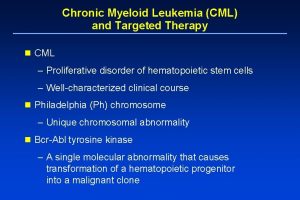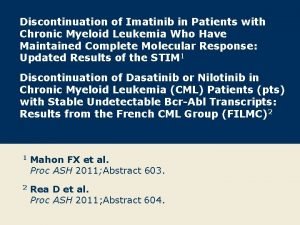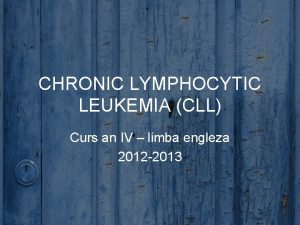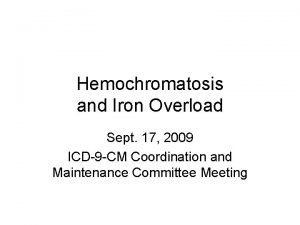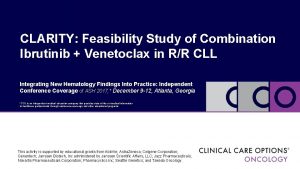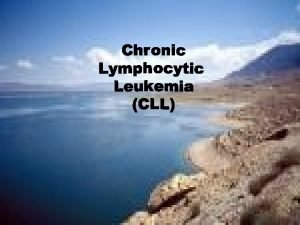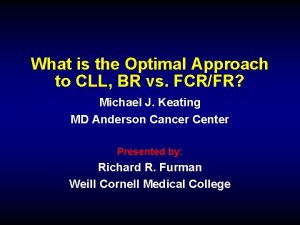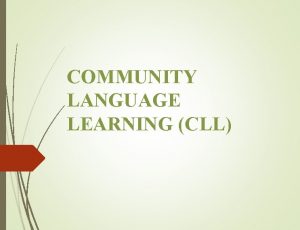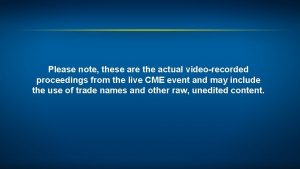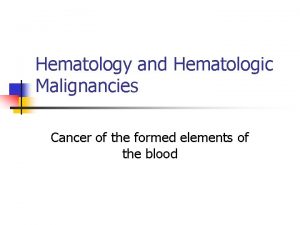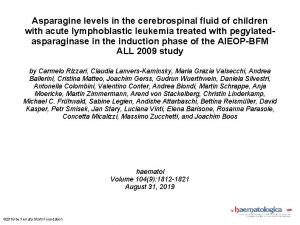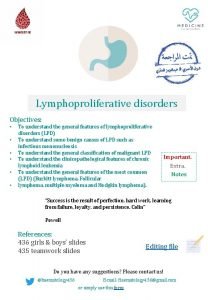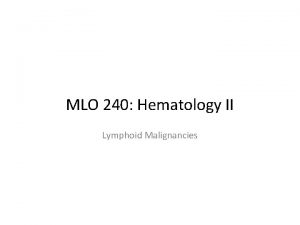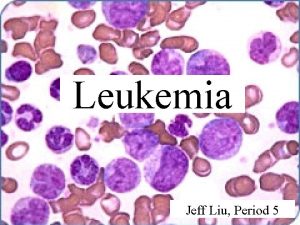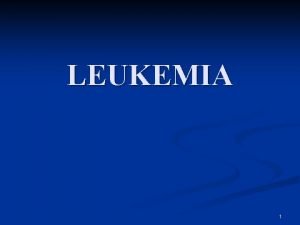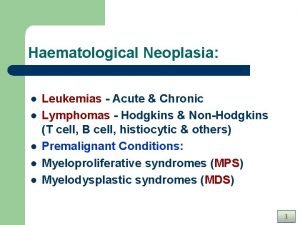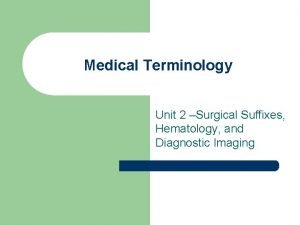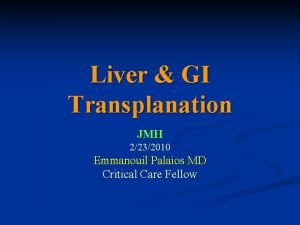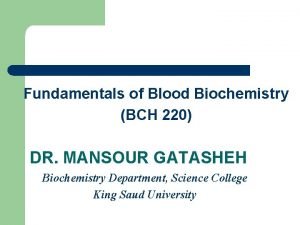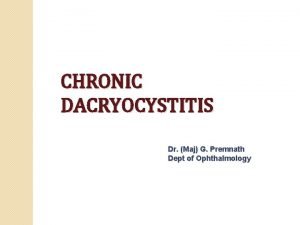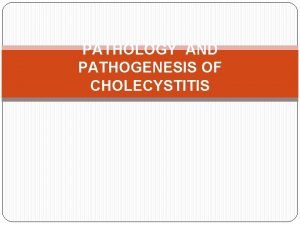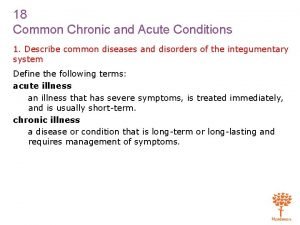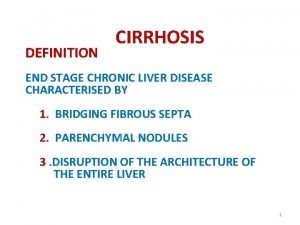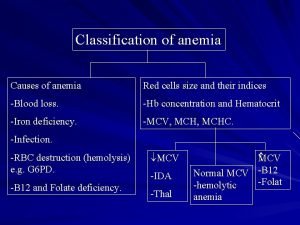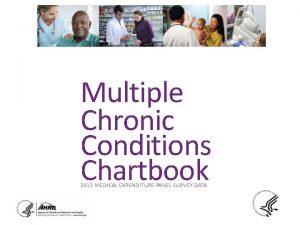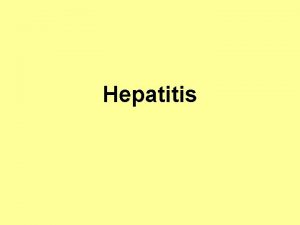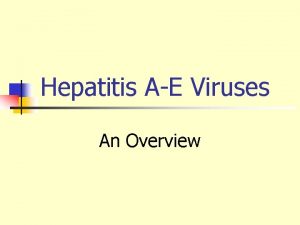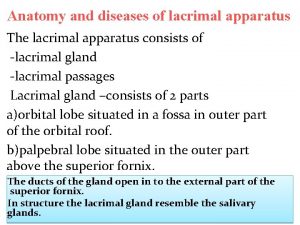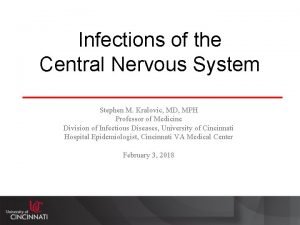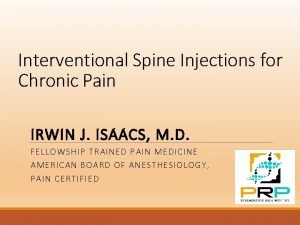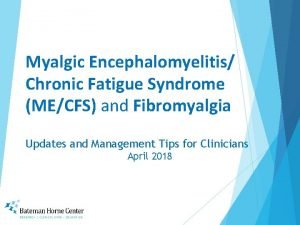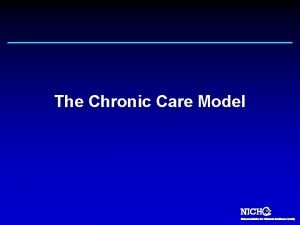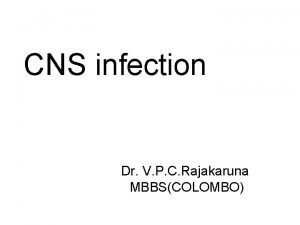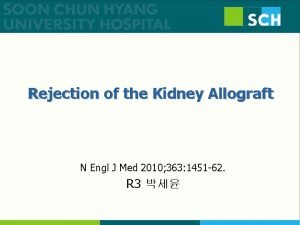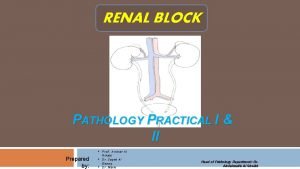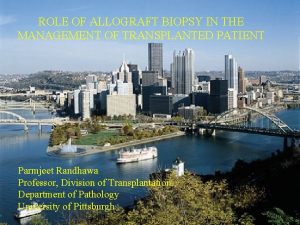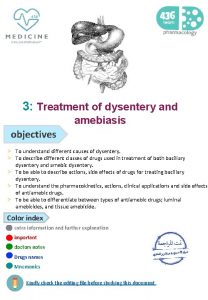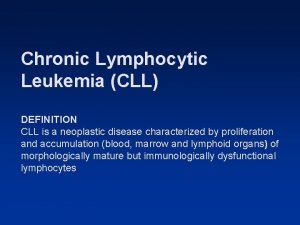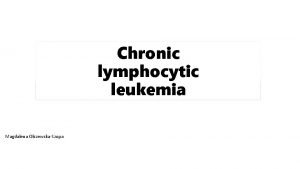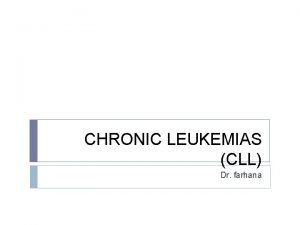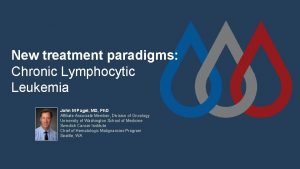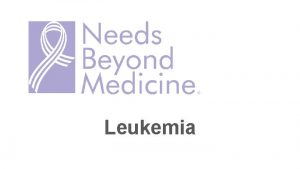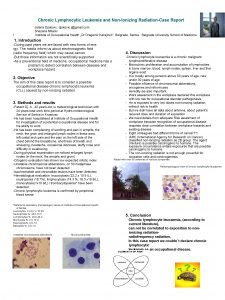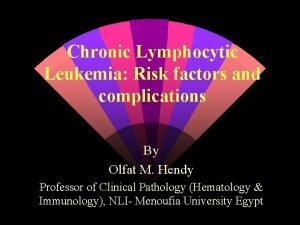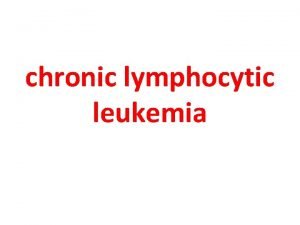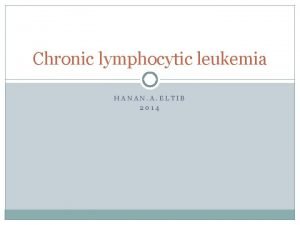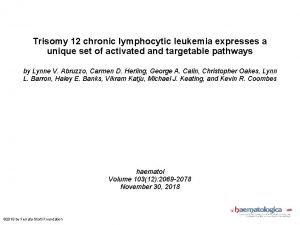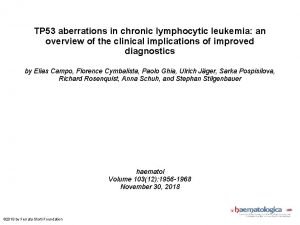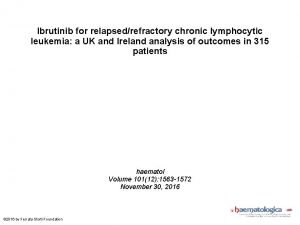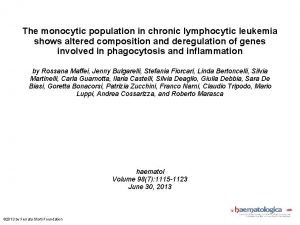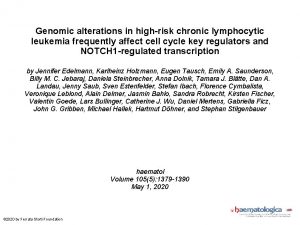Update on chronic lymphocytic leukemia CLL treatment Dr



























































































- Slides: 91

Update on chronic lymphocytic leukemia (CLL) treatment Dr Mona Yuklea Hematology Department, Meir Hospital, 2019

CLL - incidence § The most common leukemia among adults in Western Countries § 4 -6 cases /100000 person/year § At diagnosis § More than 70% of patients – older than 65 y § Median age – 72 y § 15% of patients ≤ 55 y


CLL definition § Lymphoproliferative disorder characterized by • clonal proliferation and accumulation of mature CD 19 positive B cells within the blood , BM , lymph nodes and spleen • typically CD 5 CD 23 positive with low density of CD 20





Management of CLL patients main issues Ø WHEN? (Timing ) Ø HOW ? ( The choice of treatment)




CLL - active disease • Progressive bone marrow failure • Bulky disease • Uncontrolled autoimmune cytopenias • Rapid LDT (Lymphocyte Doubling Time) • Presence of B symptoms

General considerations for the choice of therapy § Age and fitness status based on geriatric assessment (comorbidity burden and performance status, functional and mental status , need for caregiver) § Disease status ( first-line treatment vs. ≥ 2 line) § Genetic profile


Genetic profile of CLL • FISH technique – genomic aberrations in more than 80% of CLL • Deletion of long arm of chr. 13 • Trisomy 12 • Deletion of long arm of chr. 11 • Deletion of short arm of chr. 17 • Molecular testing for IGHV – mutational status (mutated vs. unmutated)








Biological background Key roles in CLL development • B-cell receptor (BCR) activation and signaling cascade • Microenvironment – interaction of leukemic cells with T lymphocytes , stromal cells • B-cell leukemia/lymphoma 2 ( BCL-2) protein overexpression → resistance to apoptosis



Biological background Key roles in CLL development • B-cell receptor (BCR) activation and signaling cascade • Microenvironment – interaction of leukemic cells with T lymphocytes , stromal cells • B- cell leukemia/lymphoma 2( BCL-2) protein overexpression → resistance to apoptosis

IBRUTINIB § First-in-class irreversibly inhibitor of BTK (Bruton tyrosine kinase) , small molecule , binds to cysteine • BTK activity is critical for B-cell survival and function



IDELALISIB § Phosphoinositide - 3 kinase delta (PI 3 K�) inhibitor § PI 3 K signaling in CLL ( through delta isoform) -important role in BCR signaling


Biological background Key roles in CLL development • B-cell receptor (BCR) activation and signaling cascade • Microenvironment – interaction of leukemic cells with T lymphocytes , stromal cells • B-cell leukemia/lymphoma 2 ( BCL-2) protein overexpression → resistance to apoptosis

BCL-2 inhibitors § VENETOCLAX § After two decades of drug discovery efforts directed toward finding potent and selective BCL-2 inhibitors § FDA approval – 4/2016 – second line for CLL pts. del 17 p




















Second generation BTK inhibitors § ACALABRUTINIB – selective BTK inhibitor designed to improve safety and efficacy § targets BTK but not other kinases (EGFR, TEC. . ) § 95% ORR in phase I - II relapse CLL, all 17 p del pts. responded § no major hemorrhage or AF



CLL - incidence § The most common leukemia among adults in Western Countries § 4 -6 cases /100000 person/year § At diagnosis § More than 70% of patients – older than 65 y § Median age – 72 y § 15% of patients ≤ 55 y

CLL definition § Lymphoproliferative disorder characterized by • clonal proliferation and accumulation of mature CD 19 positive B cells within the blood , BM , lymph nodes and spleen • typically CD 5 CD 23 positive with low density of CD 20


BCL-2 over-expression and its role in CLL

Genetic profile of CLL • FISH technique – genomic aberrations in more than 80% of CLL • Deletion of long arm of chr. 13 • Trisomy 12 • Deletion of long arm of chr. 11 • Deletion of short arm of chr. 17 • Molecular testing for IGHV – mutational status (mutated vs. unmutated)








Biological background Key roles in CLL development • B-cell receptor (BCR) activation and signaling cascade • Microenvironment – interaction of leukemic cells with T lymphocytes , stromal cells • B- cell leukemia/lymphoma 2( BCL-2) protein overexpression → resistance to apoptosis

B-cell receptor signaling

Biological background Key roles in CLL development • B-cell receptor (BCR) activation and signaling cascade • Microenvironment – interaction of leukemic cells with T lymphocytes , stromal cells • B- cell leukemia/lymphoma 2( BCL-2) protein overexpression → resistance to apoptosis

Novel targeted therapies in CLL § B-cell receptor signal transduction inhibitors § BCL 2 antagonists

BCL-2 over-expression and its role in CLL

Management of CLL patients main issues Ø WHEN? (Timing ) Ø HOW ? ( The choice of treatment)

CLL - active disease • Progressive bone marrow failure • Bulky disease • Uncontrolled autoimmune cytopenias • Rapid LDT (Lymphocyte Doubling Time) • Presence of B symptoms

General considerations for the choice of therapy § Fitness status based on geriatric assessment (comorbidity burden and performance status, functional and mental status , need for caregiver) § Disease status ( first-line treatment vs. ≥ 2 line) § Genetic profile

Novel targeted therapies in CLL § B-cell receptor signal transduction inhibitors § BCL 2 antagonists

IBRUTINIB § First-in-class irreversibly inhibitor of BTK (Bruton tyrosine kinase) , small molecule , binds to cysteine • BTK activity is critical for B-cell survival and function


Second generation BTK inhibitors § ACALABRUTINIB – selective BTK inhibitor designed to improve safety and efficacy § targets BTK but not other kinases (EGFR, TEC. . ) § 95% ORR in phase I - II relapse CLL, all 17 p del pts. responded § no major hemorrhage or AF

IDELALISIB § Phosphoinositide - 3 kinase delta (PI 3 K�) inhibitor § PI 3 K signaling in CLL ( through delta isoform) -important role in BCR signaling


BCL-2 inhibitors § VENETOCLAX § After two decades of drug discovery efforts directed toward finding potent and selective BCL-2 inhibitors § FDA approval – 4/2016 – second line for CLL pts. del 17 p








 Cml stages
Cml stages Lymphocytic pleocytosis
Lymphocytic pleocytosis Mark juckett md
Mark juckett md Chronic myeloid leukemia
Chronic myeloid leukemia Chronic myeloid leukemia
Chronic myeloid leukemia Database backup and recovery techniques
Database backup and recovery techniques Cirs score cll
Cirs score cll Binary tree to cdll
Binary tree to cdll Cll unspecified icd 10
Cll unspecified icd 10 Clarity cll trial
Clarity cll trial Cll clinical presentation
Cll clinical presentation Br cll
Br cll Community language learning cll
Community language learning cll Cll
Cll Differentiation syndrome
Differentiation syndrome Leukemia vs lymphoma
Leukemia vs lymphoma Leukémia wikipédia
Leukémia wikipédia Heinz bodies
Heinz bodies Leukemia statics
Leukemia statics Zhang wang leukemia
Zhang wang leukemia Pas stain procedure slideshare
Pas stain procedure slideshare Conclusion of leukemia
Conclusion of leukemia Pas staining principle
Pas staining principle Lymphoproliferative disease
Lymphoproliferative disease Leukemia death rate
Leukemia death rate Leukemia
Leukemia Hairy cell leukemia
Hairy cell leukemia Nk leukemia
Nk leukemia Acute mylogenous leukemia
Acute mylogenous leukemia Trombopoetik adalah
Trombopoetik adalah Leukemia statics
Leukemia statics Lll leukemia
Lll leukemia Tom root word
Tom root word Clast medical terminology
Clast medical terminology Chronic insomnia
Chronic insomnia Chronic rejection
Chronic rejection Chronic blood loss
Chronic blood loss Chronic dacryocystitis stages
Chronic dacryocystitis stages Cholecystitis pathophysiology
Cholecystitis pathophysiology Copd disease
Copd disease Chronic ulcerative pulpitis
Chronic ulcerative pulpitis Classification of antianginal drugs
Classification of antianginal drugs Chronic disease
Chronic disease Flinders model of chronic health disorders
Flinders model of chronic health disorders Common chronic and acute conditions chapter 18
Common chronic and acute conditions chapter 18 Chronic inducible urticaria
Chronic inducible urticaria Hobnail fibrotic liver
Hobnail fibrotic liver Wagner chronic care model 1998
Wagner chronic care model 1998 Peripheral stigmata of cld
Peripheral stigmata of cld The chronic complainer customer
The chronic complainer customer Ersd
Ersd Refifs
Refifs Grades of anemia
Grades of anemia Multiple chronic conditions chartbook
Multiple chronic conditions chartbook Causes of chronic hepatitis
Causes of chronic hepatitis Chronic unease in the workplace
Chronic unease in the workplace Chronic hepatitis
Chronic hepatitis Chronic rejection
Chronic rejection Chronic rejection
Chronic rejection Chronic pain comorbidities
Chronic pain comorbidities Chronic dacryocystitis
Chronic dacryocystitis Chronic care model definition
Chronic care model definition Chronic respiratory alkalosis
Chronic respiratory alkalosis Chronic medication service
Chronic medication service Chronic gastritis
Chronic gastritis Chronic meningitis
Chronic meningitis Icd 10 code for allergic reaction to peanuts
Icd 10 code for allergic reaction to peanuts Morphological patterns of chronic inflammation
Morphological patterns of chronic inflammation Chronic pain management irwin
Chronic pain management irwin Acute cholecystitis vs chronic cholecystitis
Acute cholecystitis vs chronic cholecystitis Fibromyalgia vs chronic fatigue
Fibromyalgia vs chronic fatigue Chronic care
Chronic care 5 signs of inflammation
5 signs of inflammation Kate lorig stanford
Kate lorig stanford Factors delaying wound healing
Factors delaying wound healing Wagner model of chronic disease management
Wagner model of chronic disease management Morphologic patterns of acute and chronic inflammation
Morphologic patterns of acute and chronic inflammation Meningoceal
Meningoceal Chronic unease shell
Chronic unease shell Nonalcoholic fatty liver disease
Nonalcoholic fatty liver disease Pancreatitis nursing assessment
Pancreatitis nursing assessment Acute cholecystitis causes
Acute cholecystitis causes Chronic rejection
Chronic rejection Features of cld
Features of cld Chronic misbehavior
Chronic misbehavior Chronic pancreatitis nursing care plan
Chronic pancreatitis nursing care plan Chronic calculous cholecystitis
Chronic calculous cholecystitis Respiratory acinus
Respiratory acinus Pathology
Pathology Chronic rejection
Chronic rejection Chronic diarrhea
Chronic diarrhea Chronic amebiasis
Chronic amebiasis
